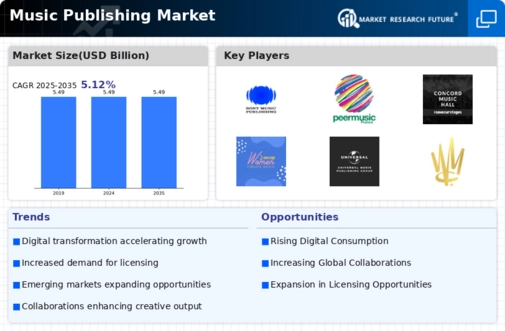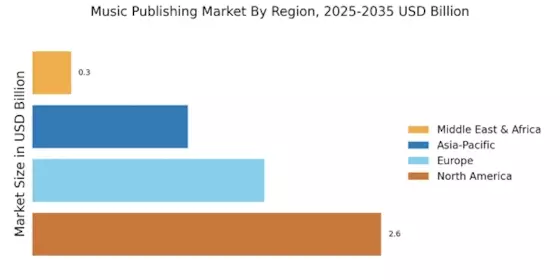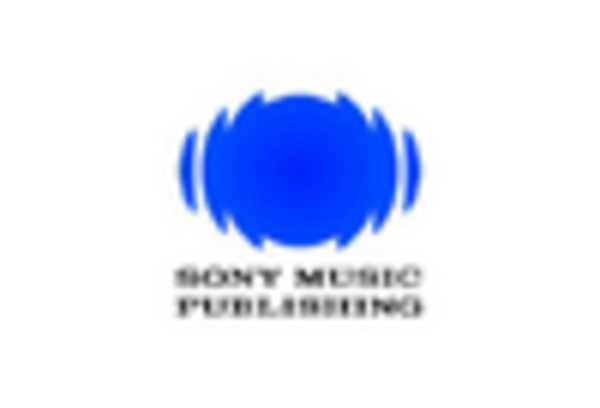Rise of Streaming Services
The proliferation of streaming services has transformed the Music Publishing Market, creating new revenue streams for songwriters and publishers. As of 2025, streaming accounts for over 80% of music consumption, indicating a shift in how music is distributed and monetized. This trend has led to an increase in licensing agreements, as platforms seek to offer diverse catalogs to attract subscribers. The demand for original content has surged, prompting publishers to invest in new talent and catalog acquisitions. Consequently, the Music Publishing Market is experiencing a renaissance, with digital platforms enabling wider reach and engagement. This shift not only benefits established artists but also provides emerging musicians with unprecedented opportunities to monetize their work. The ongoing evolution of streaming technology suggests that the Music Publishing Market will continue to adapt and thrive in this digital landscape.
Emergence of New Revenue Models
The emergence of new revenue models is reshaping the Music Publishing Market, as traditional income streams evolve in response to changing consumer behaviors. In 2025, music publishers are exploring innovative approaches such as subscription services, micro-licensing, and direct-to-fan sales. These models allow for greater flexibility and accessibility, enabling artists to monetize their work in diverse ways. The rise of platforms that facilitate direct transactions between creators and consumers is indicative of a shift towards more artist-centric revenue structures. This evolution not only empowers musicians but also challenges traditional publishing paradigms, prompting publishers to adapt their strategies. The Music Publishing Market is thus entering a phase of transformation, where the exploration of new revenue models could redefine the financial landscape for artists and publishers alike.
Increased Demand for Sync Licensing
The demand for sync licensing has become a pivotal driver in the Music Publishing Market. As visual media, including films, television shows, and advertisements, increasingly rely on music to enhance storytelling, the need for licensed tracks has surged. In 2025, the sync licensing market is projected to grow significantly, with revenues expected to reach billions. This growth is attributed to the rise of content creators and platforms seeking to differentiate their offerings through unique soundtracks. Music publishers are capitalizing on this trend by actively promoting their catalogs for sync opportunities, thereby expanding their revenue potential. The Music Publishing Market is thus witnessing a shift where the intersection of music and visual media creates lucrative opportunities for both publishers and artists. This trend indicates a promising future for those involved in music publishing, as the synergy between music and media continues to flourish.
Technological Advancements in Music Distribution
Technological advancements are reshaping the Music Publishing Market, particularly in how music is distributed and consumed. Innovations such as blockchain technology and artificial intelligence are streamlining rights management and ensuring fair compensation for creators. As of 2025, the integration of these technologies is expected to enhance transparency in royalty distribution, addressing long-standing issues within the industry. Furthermore, the rise of mobile applications and social media platforms has democratized music distribution, allowing independent artists to reach audiences directly. This shift is likely to foster a more diverse music landscape, as emerging talents gain visibility without traditional gatekeepers. The Music Publishing Market is thus evolving, with technology serving as a catalyst for change, enabling more equitable access to music and fostering creativity across various genres.
Growing Importance of Music Publishing in Brand Marketing
The role of music publishing in brand marketing is becoming increasingly vital within the Music Publishing Market. Brands are recognizing the emotional connection that music can create with consumers, leading to strategic partnerships with music publishers. In 2025, it is anticipated that more companies will invest in music licensing to enhance their advertising campaigns, leveraging popular tracks to evoke specific feelings and associations. This trend not only benefits brands seeking to differentiate themselves but also provides additional revenue streams for music publishers and artists. The Music Publishing Market is thus witnessing a convergence of marketing and music, where the strategic use of soundtracks can significantly impact brand perception and consumer engagement. This growing importance suggests that music publishing will continue to play a crucial role in shaping marketing strategies across various sectors.


















Leave a Comment